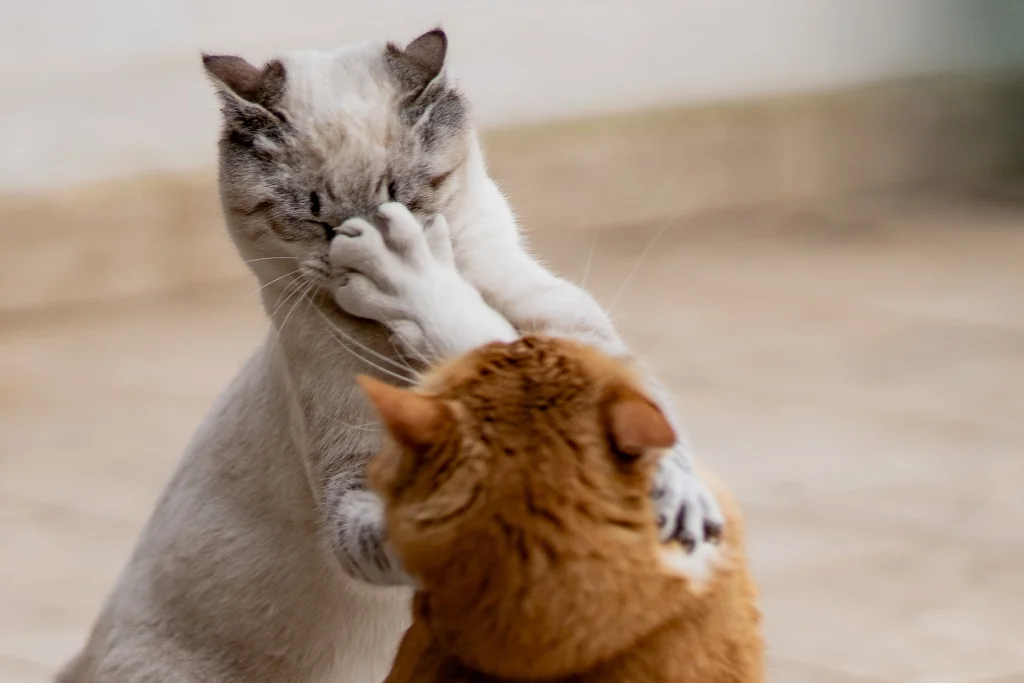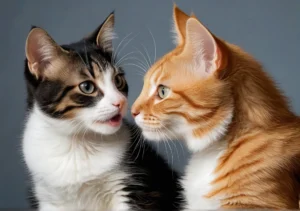Disclosure: We may earn a commission from helpful, relevant links in our content. No cost to you. See our privacy policy.
Cats may be creatures of grace and mystery, but let’s face it: their squabbles can leave you baffled.
Between the hissing, the clawing, and the territorial standoffs, maintaining peace in a multi-cat household often feels like an enigma wrapped in a riddle. You might feel like you’re playing a detective in a feline soap opera.
So, grab your magnifying glass as we dive into the world of cat conflicts, deciphering the signs, understanding the reasons, and, most importantly, learning how to restore harmony.

Spotting the Early Signs of Conflict
Cats are excellent communicators, provided you know what to look for.
Unresolved conflict often shows up as changes in behavior. Perhaps your otherwise sociable feline suddenly starts spending more time alone, or a previously peaceful cat becomes surprisingly aggressive.
Unexplained scratches or wounds on your cats can also indicate they’ve been getting physical.
Watch for changes in eating or litter box habits, too. These could all be red flags that the feline peace treaty has been breached.
Understanding the Root Causes of Disputes
A critical step to peacekeeping is understanding the root causes of disputes.
Competition over resources like food, toys, or favorite lounging spots can spark conflicts. Some cats also have a stronger need for personal space and may react adversely to overcrowding.
Changes in the household, like a new pet, can disrupt your cat’s sense of security, leading to more disputes. Even seemingly trivial changes, such as moving their litter box or rearranging furniture, can cause distress.
Remember, what may appear insignificant to you can be a major deal in the eyes of your feline companions.
Practical Steps to Manage Cat Conflicts
Handling feline disputes can be a tricky process. Here are some practical steps that will not only manage conflicts but will also enhance your cats’ overall well-being.
Establish Multiple Resources
To reduce competition, provide multiple food bowls, water dishes, and litter boxes. Ideally, have one more of each resource than the number of cats in your household.
These should be placed in different areas around the house to prevent a single cat from guarding all resources. By doing this, you not only reduce conflicts, but also foster independence in each cat.
Provide Vertical Space
Cats often establish their territories vertically. Having a variety of high spaces like shelves, cat trees, or window perches can give each cat a territory of its own and reduce territorial disputes.
Remember, height often equates to status in the feline world, so give them ample opportunity to climb!
Encourage Positive Associations
Use treats, petting, and play to help cats associate each other’s presence with positive experiences. This process, called associative learning, can help to ease tension over time. Think of it as a kitty peace treaty negotiated with snuggles and snacks!
Implement a Gradual Introduction Process for New Cats
Introduce new cats gradually. Start by keeping them in separate rooms, allowing them to smell each other under the door. Gradually allow visual contact without physical contact.
Finally, allow them to interact under supervision. This process can take days or weeks, depending on the cats involved, but they will each have their own territory and peace.
Rotate Favorite Toys
Cats can be possessive about their toys. If you notice a brewing conflict around a favorite toy, rotate it out for a few days and then reintroduce it. This can help dilute attachment and reduce disputes related to ‘ownership’ of the toy.
By incorporating these tips into your cat management strategy, you’ll create a harmonious environment where each cat feels secure and valued.

Diffusing Tension: Immediate Actions to Take
Here are a few practical ways you can try to reduce tension during a conflict between cats:
- Stop Fights Safely. If a fight breaks out, do not use your hands to separate the cats; this could result in injury to you or escalate the fight further. Instead, use a distraction like a loud noise or a water sprayer. If these methods fail, you can use a thick blanket to separate them.
- Give Them Space. Post-fight, cats need time to cool down. Separate them for a while and reintroduce them gradually when they are calm.
- Don’t Punish, Redirect. Never punish a cat for aggressive behavior, as it can make the situation worse. Instead, redirect their attention with toys or treats.
- Check for Injuries. After a fight, always check your cats for any injuries. If you notice any wounds, consult your vet immediately to prevent infection.
- Consider a Feliway Diffuser. Synthetic pheromones, like those released by a Feliway diffuser, can help to reduce tension and aggression in a multi-cat household. These pheromones mimic the “friendly markers” cats leave when they rub their faces on furniture or people, promoting a sense of security and familiarity. Try for yourself.
If conflicts continue despite your best efforts, don’t hesitate to seek help from a professional. A cat behaviorist or a certified animal behavior consultant can provide tailored strategies to address your specific situation.
Creating a Harmonious Multi-Cat Household
Creating a peaceful multi-cat household takes a little patience, understanding, and sometimes, a touch of creativity. Here are some unique steps to consider for fostering harmony among your feline companions.
- Enrich Their Environment – Besides the usual cat trees and scratching posts, consider some unconventional ways of adding enrichment. For example, bird or squirrel feeders outside windows can provide endless hours of “cat television”, reducing boredom and associated disputes.
- Play Matchmaker with Nap Time. Cats can be surprisingly sociable when they’re sleepy. Try to arrange shared nap times by tiring them out with interactive play before a scheduled meal. Post-meal, you’ll often find them dozing off in close proximity, strengthening their bond subtly over time.
- Engage in Group Training Sessions. Cats are often seen as solitary creatures, but they can learn to enjoy shared activities. Engaging in training sessions using clicker training techniques, where you can reward individual cats for positive behavior, can help foster a sense of camaraderie.
I remember when my male cat, Smokey, and our new kitten seemed to be at odds. Smokey was generally unimpressed with the new arrival, and they had several minor spats. Then, one day during a heavy downpour, I found both huddled together in a cardboard box, the tension seemingly forgotten. It’s strange but true, cats sometimes create their own peace treaties when you least expect it.
FAQs
What are the common signs of conflict between cats?
Common signs of conflict between cats include frequent hissing or growling, swatting, blocking access to resources, and avoidance behavior.
How can I tell if cat play is turning into a fight?
Cat play may be turning into a fight when the body language becomes aggressive rather than playful, such as flattened ears, dilated pupils, hissing or growling, and the fur standing on end.
What should I do during a cat fight?
During a cat fight, avoid getting physically involved. Use a distraction like a loud noise (clap your hands), water sprayer, or throw a blanket over them to break up the fight safely.
When should I consider professional help for my cats’ conflicts?
Consider professional help for your cats’ conflicts if the conflicts persist, escalate, or result in injury despite your efforts to create a peaceful environment. A professional can provide tailored strategies based on your specific situation.
Alex, a passionate animal lover, has experience in training and understanding animal behavior. As a proud pet parent to two dogs and three cats, he founded AnimalReport.net to share insights from animal experts and expand his knowledge of the animal kingdom.




